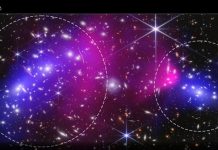
The James Webb Space Telescope (JWST) has given astronomers a remarkable new view of NGC 3256, a galaxy undergoing a dramatic transformation.
This galaxy, situated about 122 million light years away in the constellation Vela, is in the throes of a major merger. Two gas-rich disk galaxies are coming together, creating one of the brightest and most tumultuous systems close to our own Milky Way.
NGC 3256’s appearance is anything but orderly. Its spiral arms are twisted and stretched, a testament to the gravitational forces at play. Dust lanes crisscross the galaxy, obscuring parts of it and highlighting the chaos of the merger.
At the heart of this cosmic dance are two nuclei: one in the north, bursting with new stars, and another, more mysterious core in the south, shrouded in dust.
What’s particularly interesting about NGC 3256 is the molecular hydrogen outflows detected coming from these galactic centers. These outflows are crucial for understanding how the galaxy changes and evolves during the merger.
They can influence star formation, the distribution of gas in the galaxy, and even its future shape and size.
Leading the study, Thomas Bohn and his international team focused on these outflows using JWST’s advanced instruments.
They were especially interested in the outflows from the galaxy’s southern nucleus, where they discovered warm, molecular hydrogen gas being ejected into space.
These outflows stretch for about 2,300 light years and reach speeds of up to 1,000 kilometers per second. The gas is most intense at the edges of the outflows, suggesting that the process is not just powerful but also highly dynamic.
Astonishingly, the team found that the warm molecular hydrogen gas being ejected amounts to about 890,000 times the mass of the Sun. Yet, despite the intensity of these outflows, they appear to be contributing to the birth of new stars rather than stifling it.
The presence of warmer gas closer to the southern nucleus implies it’s the primary source heating the outflowing gas. This heated, outflowing gas seems to be playing a role in sparking star formation, acting more as a catalyst than a suppressor.
This discovery challenges some existing ideas about how galaxies evolve. Typically, astronomers have thought that such powerful outflows might blow away the raw materials needed to make new stars, effectively halting the process of star formation.
However, in NGC 3256, the opposite seems to be happening. The outflows might be compressing gas in certain regions, making it easier for stars to form.
The JWST’s observations of NGC 3256 open up new avenues for understanding galaxy mergers, the complexities of interstellar gas dynamics, and the intricate balance between destruction and creation in the cosmos.
This study highlights the incredible capabilities of the JWST and its role in unraveling the mysteries of the universe.
The research findings can be found in arXiv.
Copyright © 2024 Knowridge Science Report. All rights reserved.



